 Last additions - OKINAWA 沖縄県 Last additions - OKINAWA 沖縄県 |
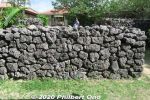
Makishi Residence privacy wall. 旧牧志邸Jan 10, 2021
|
|
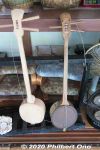
Can-type sanshin in Makishi Residence. 旧牧志邸Jan 10, 2021
|
|
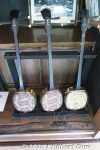
Sanshin in Makishi Residence. 旧牧志邸Jan 10, 2021
|
|
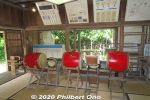
They hold traditional music performances in Makishi Residence. 旧牧志邸Jan 10, 2021
|
|
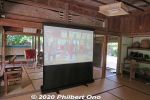
Inside Makishi Residence. 旧牧志邸Jan 10, 2021
|
|
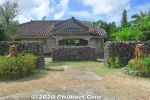
Makishi Residence is a traditional Yaeyama home. 旧牧志邸Jan 10, 2021
|
|
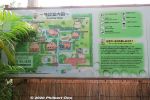
Several traditional Yaeyama homes in a park-like setting with lush greenery. "Yaima" means Yaeyama in the local Yaeyama dialect.Jan 10, 2021
|
|
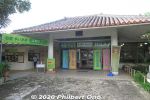
Yaima Mura is a small architectural park of traditional Yaeyama homes overlooking Nagura Bay. Open 9:00 am–5:30 pm. Adult admission ¥1,000, kids ¥500. https://www.yaimamura.com/Jan 10, 2021
|
|

Stargazing near Nosokodake. Photo by National Astronomical Observatory of Japan.Jan 10, 2021
|
|

Stargazing at Nosokodake Lookout Point. Photo by National Astronomical Observatory of Japan.Jan 10, 2021
|
|

Stargazing at Nosokodake Lookout Point. Photo by National Astronomical Observatory of Japan.Jan 10, 2021
|
|
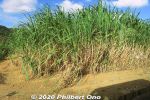
Lots of sugar cane in Yaeyama.Jan 10, 2021
|
|
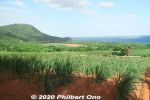
Jan 10, 2021
|
|
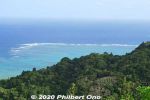
View of coral reefs from Nosokodake Lookout Point in northern Ishigaki. Jan 10, 2021
|
|

Jan 10, 2021
|
|
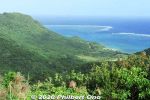
View from Nosokodake Lookout Point in northern Ishigaki. Jan 10, 2021
|
|

View from Nosokodake Lookout Point in northern Ishigaki. Jan 10, 2021
|
|
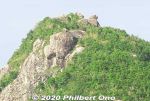
Even today, people who climb the mountain look for the Maape rock and assume this or that rock is her.This story is based on historical fact. The Ryukyu government sometimes forced people to migrate to undeveloped lands to start farming to increase agricultural production so they could pay more taxes. The kingdom was being heavily taxed by the Satsuma Domain in Kagoshima, and taxes had to paid in rice per head.
Read more about the folk tale here: https://photoguide.jp/log/2020/12/yaeyama-folk-songs-nosokodake-maape/Jan 10, 2021
|
|
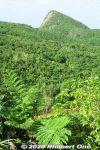
So she and her family were forced to move here to Nosokodake to start a new farming village and clear the thick jungle for farming. It was a hard life. Maape desperately missed her beloved Kanimui and couldn't forget him.
One day, she wanted to at least see Kuroshima where he lived, so she climbed up Mt. Nosokodake. At the top, she looked for Kuroshima, but her view of the island was blocked by Mt. Omotodake, Ishigaki's highest mountain. She collapsed on her knees and wailed in sorrow. Later, a worried villager looked for Maape who never returned home. On the top of the mountain, he found a crying rock gazing in the direction of Kuroshima. Maape had turned into stone.Jan 10, 2021
|
|
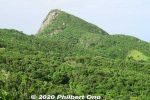
Side view of Mt. Nosokodake. This mountain is associated with a famous local folk tale about a girl named Maape. The mountain is nicknamed after her, "Nosoko Maape" (野底マーペー).On the nearby island of Kuroshima (黒島) in the 18th century, Maape and her childhood sweetheart, Kanimui, were happily living as farmers. They were to be married someday.
However, one day, a Ryukyu government decree ordered half the island's residents to move here near Nosokodake on Ishigaki while the other half could remain on Kuroshima. The island's population was split along the island's main road. Maape and Kanimui lived on the opposite sides of the road, and Maape was on the side where people had to move to Ishigaki.Jan 10, 2021
|
|
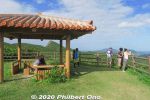
Nosokodake Lookout Point in northern Ishigaki. Under the roof is a side view of Mt. Nosokodake. 野底岳展望台Jan 10, 2021
|
|

Entering Iriomote-Ishigaki National Park. Nosokodake is part of the national park.Jan 10, 2021
|
|
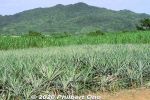
Some pineapple on Ishigaki.Jan 10, 2021
|
|
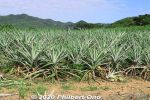
Some pineapple on Ishigaki. No fruit in autumn though.Jan 10, 2021
|
|
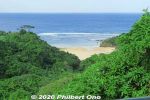
On the way to Mt. Nosoko, spotted a nice beach.Jan 10, 2021
|
|

Mt. Nosokodake (野底岳), Ishigaki’s second highest mountain at 282 m. Can be climbed up a steep, narrow trail in about 15 min. We didn't climb it though.Jan 10, 2021
|
|
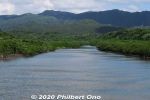
Maira River, Iriomote. There's a waterfall upstream, but we didn't have time.Jan 09, 2021
|
|
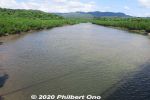
Maira River, Iriomote.Jan 09, 2021
|
|
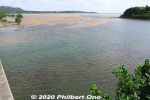
Mouth of Maira River at low tide when we passed by the day before.Jan 09, 2021
|
|
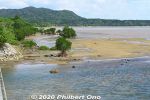
Mouth of Maira River at low tide when we passed by the day before.Jan 09, 2021
|
|
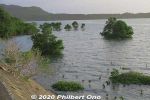
Mouth of Maira River at high tide. The brackish water is quite shallow, no more than 1 or 2 feet deep.Jan 09, 2021
|
|

Lovely morning, too bad we didn't have time to kayak more upstream on Maira River, Iriomote.Jan 09, 2021
|
|
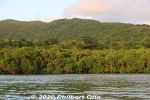
Maira River lined with mangroves.Jan 09, 2021
|
|
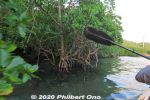
After the sunrise, we paddled along the mangroves on the river's edge.Jan 09, 2021
|
|
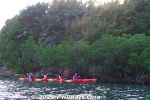
After the sunrise, we paddled along the mangroves on the river's edge.Jan 09, 2021
|
|
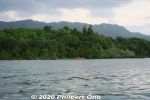
Jan 09, 2021
|
|
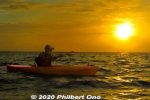
Our guide was Harubaru, but he doesn't normally do sunrise kayaking unless you ask him to: http://harubaru-iriomote.okinawa/course/Jan 09, 2021
|
|

Sunrise kayaking on Iriomote, Yaeyama, Okinawa.Jan 09, 2021
|
|
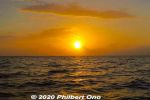
Iriomote sunrise at Maira River.Jan 09, 2021
|
|
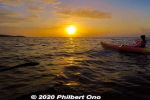
Sunrise kayaking on Iriomote, Yaeyama, Okinawa.Jan 09, 2021
|
|
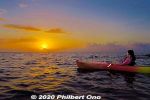
Sunrise kayaking on Iriomote, Yaeyama, Okinawa.Jan 09, 2021
|
|
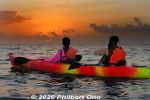
A few clouds, but the sunrise was getting to be nice.Jan 09, 2021
|
|
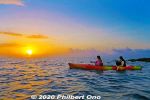
We anchored to watch the sunrise.Jan 09, 2021
|
|

We were on time for the sunrise.Jan 09, 2021
|
|
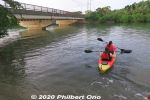
Off we go. The water was shallow, but we still wore lifejackets.Jan 09, 2021
|
|
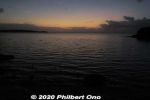
Mouth of Maira River (マイラ川) before sunrise, short drive from the main town of Ohara. Sunrise was about 6:50 am. Jan 09, 2021
|
|
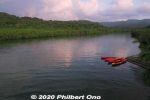
There was this dock where we could get on our kayaks. Maira River, Iriomote.Jan 09, 2021
|
|
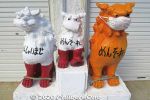
Near the Himeyuri site, Seesa lions with masks.Jan 09, 2021
|
|
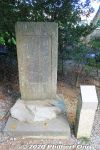
Poetry by Ii Fumiko (1917–2004 井伊文子) who was a great granddaughter of the last Ryukyu King, Sho Tai. She was married to the mayor of Hikone, Shiga Prefecture who was a descendant of the Ii Clan.井伊文子の歌碑Jan 09, 2021
|
|
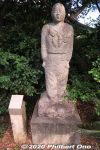
Statue of a Himeyuri high school student nurse.Jan 09, 2021
|
|
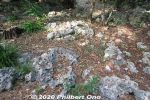
Himeyuri Cenotaph site is very rocky.Jan 09, 2021
|
|
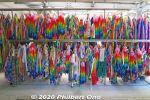
Origami at Himeyuri Cenotaph site.Jan 09, 2021
|
|
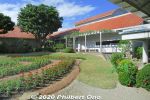
Himeyuri Peace Museum courtyard.Jan 09, 2021
|
|
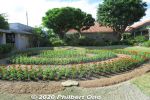
Himeyuri Peace Museum courtyard.Jan 09, 2021
|
|
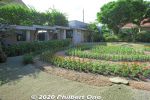
Himeyuri Peace Museum courtyard.Jan 09, 2021
|
|
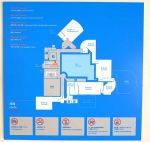
Himeyuri Peace Museum layout. Photography not allowed inside the museum.Jan 09, 2021
|
|
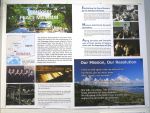
About the Himeyuri Peace Museum. It opened in June 1989.Jan 09, 2021
|
|
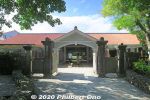
Near the Himeyuri Cenotaph is the Himeyuri Peace Museum. The building was modeled after one of the Himeyuri schools. ひめゆり平和祈念資料館http://www.himeyuri.or.jp/EN/info.htmlJan 09, 2021
|
|
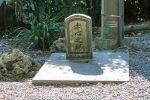
Sekishin Cenotaph 赤心之塔Jan 09, 2021
|
|
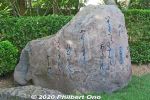
Iwa-makura Monument has a tanka poem by Nakasone Seizen who was one of the teachers of the Himeyuri students. いわまくら碑Jan 09, 2021
|
|

About the Himeyuri Cenotaph in English.Jan 09, 2021
|
|
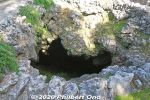
The cave goes down deep by 14 meters. They used a ladder for access.Jan 09, 2021
|
|

Below the Himeyuri monument, this cave is one of numerous natural caves in this area where the student nurses and local people took shelter. Jan 09, 2021
|
|
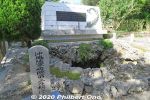
The white Himeyuri Cenotaph was renovated in 2009.Jan 09, 2021
|
|
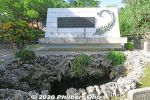
Himeyuri Cenotaph (white). The white monument is more recent, also inscribed with an updated list of names of the deceased student nurses and stores their remains in the back.Jan 09, 2021
|
|
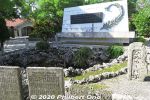
Himeyuri Cenotaph (white) and older monuments. Seen on the left is the Himeyuri Peace Museum. 第三外科壕Jan 09, 2021
|
|
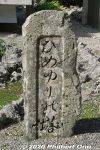
Original Himeyuri Cenotaph monument built here in 1946.Jan 09, 2021
|
|
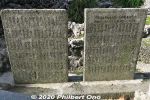
The two monuments were also placed here in 1946 inscribed with the names of the deceased student nurses.Himeyuri student nurses were Okinawan high school conscripts trained by the Japanese Army to serve at the Army Field Hospital which was a muddy and filthy underground bunker in a place called Haebaru from late March 1945. The hospital was slightly north of this area. As US forces advanced south, the hospital and nurses evacuated south to this area. Patients who couldn't walk overnight to evacuate were left behind.Jan 09, 2021
|
|
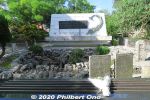
Himeyuri Cenotaph (white) built in 1957 and older monuments. The small stone monument on the right is the original Himeyuri Monument that was placed here in 1946. ひめゆりの塔This monument stands over the entrance of the cave where 80 people died on June 19, 1945 when US troops searching for Japanese soldiers threw in white phosphorus grenades. It's like a smoke bomb that suffocates people. Those who died included 38 Himeyuri high school student nurses and four of their teachers. US troops didn't know who were in the caves.Jan 09, 2021
|
|
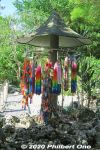
Origami displayJan 09, 2021
|
|
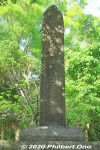
Monument for medical staff who died in the Battle of Okinawa.Jan 09, 2021
|
|
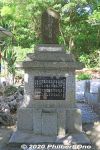
Monument for the Army Field Hospital's Third Surgical Staff. Jan 09, 2021
|
|

Monument for the medical staff who died in the Battle of Okinawa. Jan 09, 2021
|
|
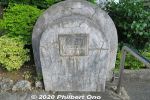
Monument for the land donation.Jan 09, 2021
|
|

Harry Shinichi Gima worked as an engineer on a US military base in Okinawa and visited Himeyuri Monument in 1951. He wanted the story and place to be presented more properly, so he quietly donated the money to the Himeyuri Alumini Association to buy the land.
This area was originally just a grassy area. None of the asphalt or cement we see here today. The land was privately owned.Jan 09, 2021
|
|

Monument for Harry Shinichi Gima (儀間真一), an Okinawan-American nisei from Hawaii who donated money to buy the land here to build the Himeyuri memorials and museum. His parents immigrated to Hawaii from Yomitan.Jan 09, 2021
|
|
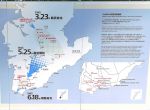
The war's progression.Jan 09, 2021
|
|
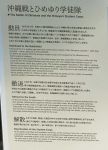
About the Himeyuri-no-Tou monuments.Jan 09, 2021
|
|
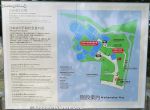
Map of Himeyuri Monument site.Jan 09, 2021
|
|
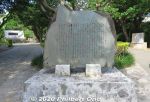
Himeyuri Chronology, inscribed with what happened here.Jan 09, 2021
|
|
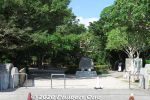
Himeyuri Monument and Cenotaph is one of Okinawa's most famous war sites and memorials.Jan 09, 2021
|
|
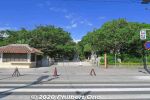
Entrance to Himeyuri Monument and Cenotaph (ひめゆり慰霊碑) in southern Okinawa in the city of Itoman. Building on the left is a flower vendor (closed).Jan 09, 2021
|
|
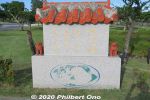
"Life is a Treasure..."Jan 09, 2021
|
|
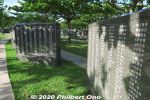
Jan 09, 2021
|
|
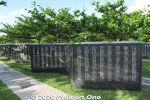
Jan 09, 2021
|
|
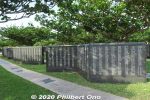
Jan 09, 2021
|
|
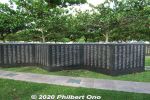
Jan 09, 2021
|
|
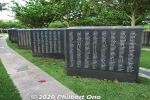
Jan 09, 2021
|
|
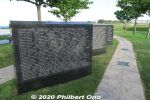
Slabs for 14,000+ Americans who died in Okinawa.Jan 09, 2021
|
|
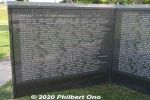
Names of 14,000+ Americans who died in Okinawa.Jan 09, 2021
|
|
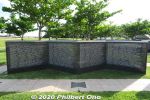
Names of 14,000+ Americans who died in Okinawa.Jan 09, 2021
|
|
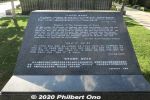
About the Cornerstone of Peace.Jan 09, 2021
|
|
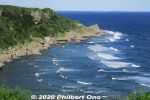
Mabuni CliffJan 09, 2021
|
|
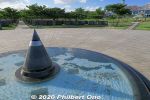
Flame of Peace in the world map. Japan can be seen in the map. 平和の火 Jan 09, 2021
|
|
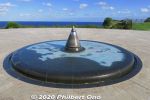
Flame of Peace in the world map. 平和の火Jan 09, 2021
|
|

Flame of Peace at the center of the Peace Plaza on the oceanfront. 平和の火Jan 09, 2021
|
|
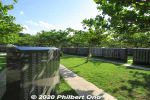
Jan 09, 2021
|
|
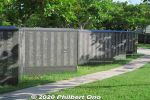
Jan 09, 2021
|
|
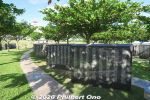
Jan 09, 2021
|
|
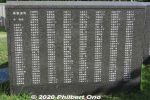
Jan 09, 2021
|
|
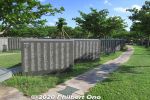
Jan 09, 2021
|
|

Map of where people's names are inscribed. Okinawans are inscribed according to their hometowns. Nearby are also war memorials for each prefecture.Jan 09, 2021
|
|

Stone slabs are like folding screens in a slight zig-zag pattern.Jan 09, 2021
|
|
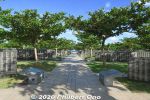
Japanese victims are inscribed by prefecture. Foreign nationals are inscribed by country.Jan 09, 2021
|
|
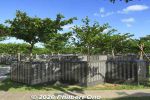
Stone slabs inscribed with over 240,000 names of people who died in the battle. Civilians and military, Japanese and foreign.Jan 09, 2021
|
|
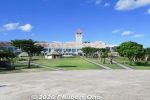
Okinawa Prefectural Peace Memorial Museum (沖縄県平和祈念資料館)Jan 09, 2021
|
|
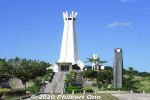
Peace Prayer Memorial Hall in the Okinawa Prefectural Peace Park.Jan 09, 2021
|
|
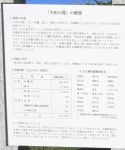
About the Cornerstone of Peace. http://www.peace-museum.pref.okinawa.jp/Jan 09, 2021
|
|
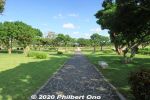
Walking to the Cornerstone of Peace.Jan 09, 2021
|
|
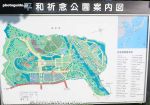
Map of Cornerstone of Peace witin the Okinawa Peace Prayer Park.Jan 09, 2021
|
|
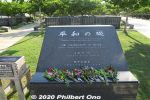
Cornerstone of Peace (平和の礎) in Mabuni, a large oceanfront memorial park full of these stone slabs inscribed with over 240,000 names of people who died in the battle. Jan 09, 2021
|
|

ANA InterContinental Manza Beach Resort as seen from Manzamo. Jan 09, 2021
|
|

Jan 09, 2021
|
|

View from Manzamo.Jan 09, 2021
|
|
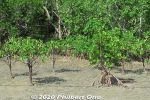
Iriomote mangroves.Jan 09, 2021
|
|
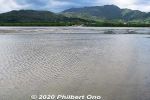
Iriomote across the shallow water.Jan 09, 2021
|
|
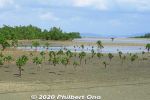
Iriomote mangroves.Jan 09, 2021
|
|
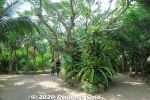
Jan 09, 2021
|
|
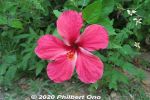
HibiscusJan 09, 2021
|
|
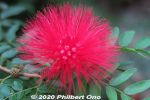
Jan 09, 2021
|
|
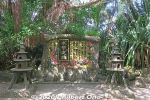
Water Buffalo MonumentJan 09, 2021
|
|
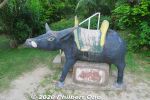
Lots of water buffalo sculptures on Yubu.Jan 09, 2021
|
|
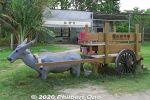
Lots of water buffalo monuments and sculptures on Yubu.Jan 09, 2021
|
|
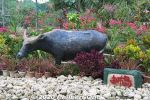
Lots of water buffalo monuments and sculptures on Yubu.Jan 09, 2021
|
|
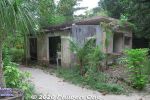
Old elementary and jr. high school on Yubu.Jan 09, 2021
|
|
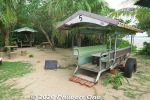
A nice cafe at Manta Beach on Yubu. Sit on old water buffalo carts.Jan 09, 2021
|
|
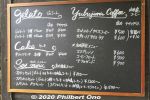
A nice cafe at Manta Beach on Yubu.Jan 09, 2021
|
|
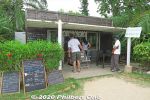
A nice cafe at Manta Beach on Yubu. マンタの浜Jan 09, 2021
|
|
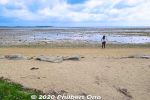
Manta Beach on Yubu. マンタの浜Jan 09, 2021
|
|
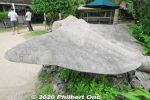
Manta Beach on Yubu. マンタの浜Jan 09, 2021
|
|
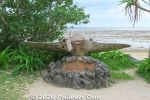
Manta Beach on Yubu. マンタの浜Jan 09, 2021
|
|
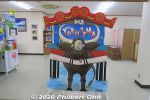
Jan 09, 2021
|
|
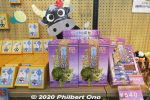
Gift shop inside the restaurant. The Iriomote Wildcat is used as a tourist smbol everywhere, but we can never see the real cat.Jan 09, 2021
|
|
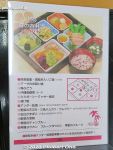
Our Okinawan lunch (Makunouchi Bento Akabana). Very good.Jan 09, 2021
|
|
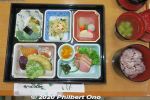
Lunch was named, "Okinawa Makunouchi Bento Akabana" (沖縄幕の内弁当「アカバナ」. ("Akabana" means "hibiscus" in Okinawan.) Price was ¥1,320.Iriomote black rice, champuru, brown sugar yokan: 西表産黒紫米入りごはん、アーサのお吸い物、うみぶどう、ミミガー、漬物、沖縄黒糖煮、 アンダー味噌、野菜天ぷら、ウムクジ(紅イモを米粉であえて揚げたもの)、かまぼこ、チャンプ ルー、黒糖羊羹Jan 09, 2021
|
|
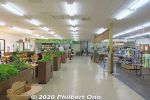
Inside the restaurant on YubuJan 09, 2021
|
|
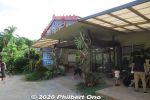
There's a restaurant on Yubu.Jan 09, 2021
|
|
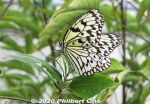
Large tree nymph (Ogomadara), Japan's largest butterfly. Wingspan 95mm or more. Very eye-catching and elegant glider. オオゴマダラ(大胡麻斑) Butterfly hothouse in Yubu (蝶々園).Jan 09, 2021
|
|
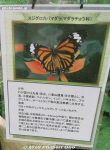
About the common tiger butterfly or Danaus genutia. スジグロカバマダラ Butterfly hothouse in Yubu (蝶々園).Jan 09, 2021
|
|
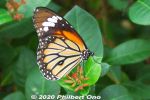
Common tiger butterfly (from India) or Danaus genutia. Looks like the monarch butterfly common in Hawaii. スジグロカバマダラ Butterfly hothouse in Yubu (蝶々園).Jan 09, 2021
|
|
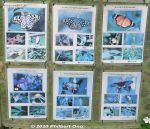
Kinds of butterflies in the butterfly garden (蝶々園). It's a greehouse full of flowers and plants, so it's quite warm.Jan 09, 2021
|
|

Way to butterfly hothouse (蝶々園).Jan 09, 2021
|
|
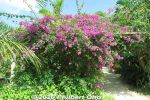
Bougainvillea on Yubu, in bloom year round.Jan 09, 2021
|
|
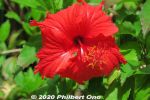
Red hibiscusJan 09, 2021
|
|
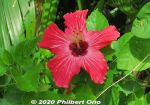
Red hibiscusJan 09, 2021
|
|
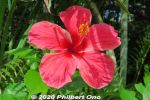
Red hibiscusJan 09, 2021
|
|
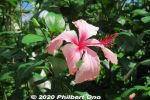
Lots of tropical flowers on Yubu Island, especially hibiscus.Jan 09, 2021
|
|
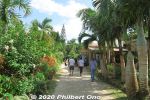
Jan 09, 2021
|
|
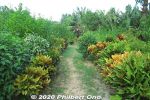
Jan 09, 2021
|
|
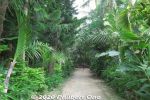
Jan 09, 2021
|
|
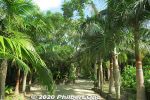
Yubu is a very lush, green island.Jan 09, 2021
|
|
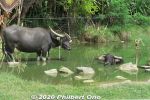
Water buffalo pond on Yubu.Jan 09, 2021
|
|
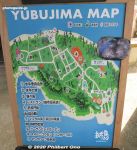
Map of Yubu sights and attractions.Jan 09, 2021
|
|
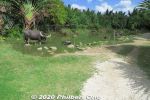
Water Buffalo Pond (水牛の池) on Yubu.Jan 09, 2021
|
|
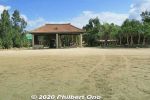
Yubu arrival station. (Admission charged, included in the water buffalo cart ride.) https://yubujima.com/Jan 09, 2021
|
|
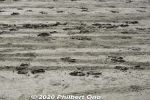
Water buffalo hoof prints.Jan 09, 2021
|
|

Water buffalo footprints.Jan 09, 2021
|
|
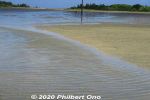
Also possible to walk over to Yubu and not pay for the water buffalo ride, but no one does this.Jan 09, 2021
|
|

Water buffalo taking toursts to Yubu Island from Iriomote.Jan 09, 2021
|
|
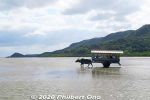
Water buffalo cart ride (水牛車 suigyusha) from Mihara (美原) to Yubu island (Yubu-jima 由 布島) takes 15 min.*Water buffalo cart roundtrip and Yubu island admission for adults: ¥1,760, Children (elementary school and below): ¥880 https://yubujima.com/Jan 09, 2021
|
|
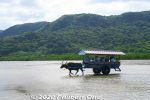
Water buffalo taking tourists to Yubu Island from Iriomote.Jan 09, 2021
|
|
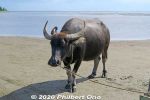
The water buffalo all have names and are highly trained to put on the harness by itself. They originally came from Taiwan.Jan 09, 2021
|
|
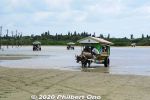
Water buffalo carts coming back from Yubu.Jan 09, 2021
|
|
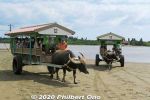
The cart is driven by a guide who usually plays the sanshin for passengers as the water buffalo sloshes to the island.Jan 09, 2021
|
|
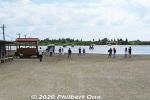
We ride these water buffalo carts to the island across shallow water. Jan 09, 2021
|
|
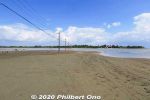
Yubu is a small, sandbar island near Mihara, Iriomote. They converted the island into a lush botanical garden. Jan 09, 2021
|
|
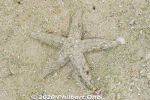
Sure enough, a well-disguised starfish moving in slow motion. Hope it's not the kind that eats coral or other native species. Kabira Bay, Ishigaki.Jan 09, 2021
|
|
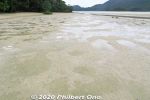
While walking here, I looked down since my intuition told me I might find something...Jan 09, 2021
|
|
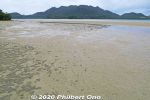
Jan 09, 2021
|
|

On another part of Kabira Bay, typical low-tide beach in Yaeyama. Ahead is the main part of Kabira Bay with the glass bottom boats and former Kabira Village.Jan 09, 2021
|
|
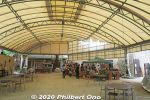
Souvenir shopsJan 09, 2021
|
|
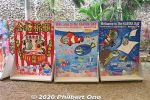
Photo cutoutsJan 09, 2021
|
|
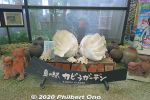
Jan 09, 2021
|
|
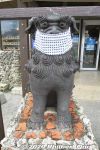
Seesa lion dog with mask, Ishigaki.Jan 09, 2021
|
|
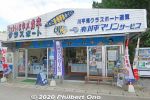
Glass bottom boat tour vendor.Jan 09, 2021
|
|
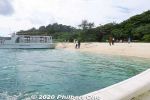
Back to the beach.Jan 09, 2021
|
|
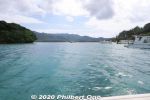
Jan 09, 2021
|
|
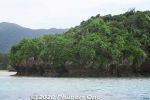
Jan 09, 2021
|
|
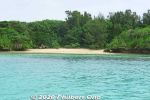
Jan 09, 2021
|
|
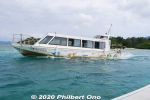
Jan 09, 2021
|
|

Jan 09, 2021
|
|
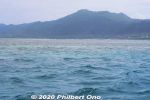
Jan 09, 2021
|
|
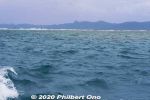
Jan 09, 2021
|
|
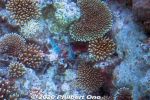
Parrot fish in Kabira Bay.Jan 09, 2021
|
|
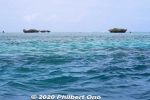
Jan 09, 2021
|
|
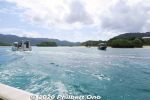
Jan 09, 2021
|
|
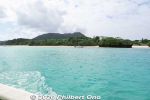
Jan 09, 2021
|
|

Jan 09, 2021
|
|
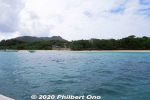
Jan 09, 2021
|
|
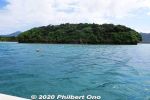
Jan 09, 2021
|
|
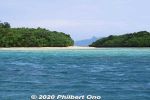
Jan 09, 2021
|
|
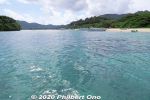
The cruise is scenic with tropical ocean and small islands.Jan 09, 2021
|
|
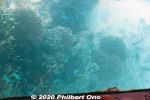
Glass bottom boat in Kabira Bay, Ishigaki.Jan 09, 2021
|
|
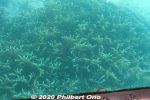
Glass bottom boat in Kabira Bay, Ishigaki.Jan 09, 2021
|
|
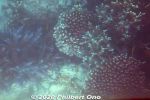
Glass bottom boat in Kabira Bay, Ishigaki.Jan 09, 2021
|
|
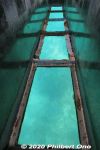
Glass bottom boat in Kabira Bay, Ishigaki.Jan 09, 2021
|
|

Typical glass bottom boat in Kabira Bay, Ishigaki.Jan 09, 2021
|
|
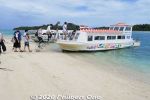
Boarding a glass bottom boat. Your feet don't get wet.Jan 09, 2021
|
|
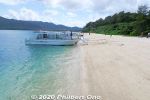
Jan 09, 2021
|
|

Kabira Bay beach.Jan 09, 2021
|
|

There are many glass bottom boats that operate here.Jan 09, 2021
|
|
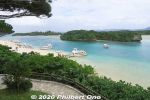
Kabira Bay on Ishigaki, perhaps the island's most famous tourist spot. Glass bottom boats to see coral and tropical fish in shallow water.Jan 09, 2021
|
|
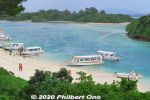
Kabira Bay, Ishigaki. It's actually a large bay and this is only a small part of it. Scenic with white beach, blue ocean, small islands and coral on the bottom.Jan 09, 2021
|
|

My video of Okinawan dances like yotsudake and a karate dance.Jul 11, 2014
|
|
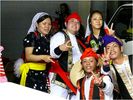
For their parting shot, these Eisa dancers couldn’t resist flashing the Peace sign along with their smiles for the camera. Photo copyright 2009 Michael Lynch.Jun 15, 2009
|
|
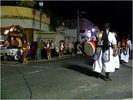
Different color yukata and uniforms of the dancers are worn, depending on which district or village they represent.Photo copyright 2009 Michael Lynch.Jun 15, 2009
|
|
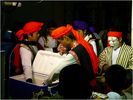
Here a group of men reach into a cooler for some refreshments while on a quick break from dancing. They will pile on trucks and move to the next location, performing Eisa dances well past midnight at every street, in every village for miles around.Photo copyright 2009 Michael Lynch.Jun 15, 2009
|
|

The large banner or flag carried on a bamboo pole is known as Hatagashisa and also represents a village or district. Each has their own unique design and the team takes pride in displaying it as a symbol of strength and prosperity for their hometown.Photo copyright 2009 Michael Lynch.Jun 15, 2009
|
|
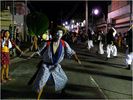
Here the Buffoon (called Gajangani) can be seen going in the opposite direction of all the other male dancers and waving a banana leaf. Some clowns carry bottles of sake and try to get bystanders to drink with them.Photo copyright 2009 Michael Lynch.Jun 15, 2009
|
|
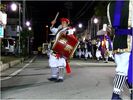
The large drum used for marching is slightly smaller than a Taiko and is called an Odaiko drum. The drummer in this photo is the only female player of this team to play such a large drum and she smiles and beats it enthusiastically.Photo copyright 2009 Michael Lynch.Jun 15, 2009
|
|
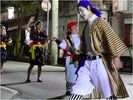
The brown and beige garment worn by this Buffoon is hand woven clothing called Bashofu. It is made from the fiber of banana plants. There may be two or three of these characters with each Eisa group skipping and weaving through the dancers as if they...The brown and beige garment worn by this Buffoon is hand woven clothing called Bashofu. It is made from the fiber of banana plants. There may be two or three of these characters with each Eisa group skipping and weaving through the dancers as if they weren’t there. Photo copyright 2009 Michael Lynch.Jun 15, 2009
|
|
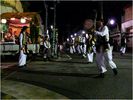
Each team of Eisa dancers has its own band riding in the back of a straw roof-covered truck. Sanshin (3 stringed instrument) players sing and play Okinawan folk music accompanied by CD’s blasted over a loudspeaker system. Photo copyright 2009 Michael Lynch.Jun 15, 2009
|
|
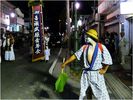
The Buffoon, Clown, or Town Drunk is a man who zig-zags through the line of dancers to the beat of his own drum, entertaining everyone and chasing evil spirits away.Photo copyright 2009 Michael Lynch.Jun 15, 2009
|
|
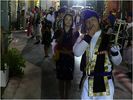
During each brief pause in the Eisa music, the men make a loud whistling noise that is distinctly Okinawan. All photos copyright 2009 Michael Lynch.Photo copyright 2009 Michael Lynch.Jun 15, 2009
|
|
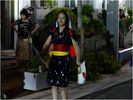
Eisa dancing is performed on the streets at night in every village on Okinawa during the three days of Obon, late in August. Here a young lady dressed in traditional Okinawan yukata (an informal kimono) marches while waving Rising Sun paper fans.Photo copyright 2009 Michael Lynch.Jun 15, 2009
|
|
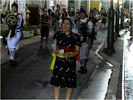
The Eisa dancers are all unmarried men and women between 20 and 30 years of age. The small handheld drums, known as Panraku, have the traditional symbol of Okinawa painted in gold on them.Photo copyright 2009 Michael Lynch.Jun 15, 2009
|
|
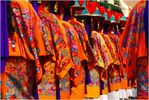
October: A parade of traditional Okinawan Kimonos and headwear takes place every year on Kokusai Street in Naha, where a reenactment of the coronation of the King and Queen of the Ryukyu Kingdom is performed.Photo copyright 2009 Michael Lynch.Jun 15, 2009
|
|
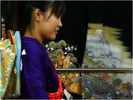
September: This young lady is trying on Kimonos at a shop in Naha in preparation for “Coming of Age Day” which is celebrated in January. During the 3d week of January, all who turned twenty years of age during the past year are initiated as adults..September: This young lady is trying on Kimonos at a shop in Naha in preparation for “Coming of Age Day” which is celebrated in January. During the 3d week of January, all who turned twenty years of age during the past year are initiated as adults. Her mother is preparing her early. Photo copyright 2009 Michael Lynch.Jun 15, 2009
|
|
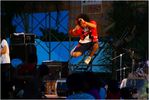
August: The lively lead-singer of a popular band named Zukan jumps and shouts while performing at the Kin Festival. During the summer months there are festivals every weekend, somewhere on the island.Photo copyright 2009 Michael Lynch.Jun 15, 2009
|
|
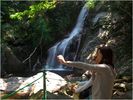
June: Hiji Waterfall in Kunigami is the largest in Okinawa and attracts many visitors from mainland Japan. It provides a refreshing, cool break after the 45 minute hike, along a nature trail, to reach this beautiful scene.Photo copyright 2009 Michael Lynch.Jun 15, 2009
|
|
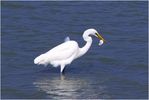
December: A white Pacific Reef Egret catches breakfast on the east coast of Okinawa. Photo copyright 2009 Michael Lynch.Photo copyright 2009 Michael Lynch.Jun 15, 2009
|
|
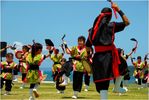
May: Eisa, a dance originally associated with ancestor worship during the Obon holidays, is now practiced at any festival or cultural event. Here, at Henza Island, a small festival celebrating Golden Week, the spirit of Okinawa was demonstrated in musicMay: Eisa, a dance originally associated with ancestor worship during the Obon holidays, is now practiced at any festival or cultural event. Here, at Henza Island, a small festival celebrating Golden Week, the spirit of Okinawa was demonstrated in music and dance to the enjoyment of all in attendance. Photo copyright 2009 Michael Lynch.Jun 15, 2009
|
|
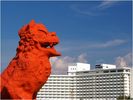
July: A Shisa (Lion-Dog) seems to dwarf the Royal Hotel in Yomitan, which is on the West coast of the island. Another influence from trade with China, the Shisa may be seen everywhere in the Prefecture, warding off evil spirits. This one stands...July: A Shisa (Lion-Dog) seems to dwarf the Royal Hotel in Yomitan, which is on the West coast of the island. Another influence from trade with China, the Shisa may be seen everywhere in the Prefecture, warding off evil spirits. This one stands around 30 feet tall, most tile-roofed homes have Shisa closer to a foot tall guarding them, either mounted on the roof or walls surrounding the house. Photo copyright 2009 Michael Lynch.Jun 15, 2009
|
|
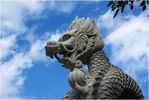
November: This dragon statue guards the corner in front of the Uruma City office. Dragons are part of many Asian sea-faring cultures folklore and Okinawa also holds year-round Dragon boat races.Photo copyright 2009 Michael Lynch.Jun 15, 2009
|
|
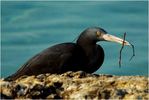
April: A black Pacific Reef Egret gathers building materials for a nest at Red Beach. Photo copyright 2009 Michael Lynch.Photo copyright 2009 Michael Lynch.Jun 15, 2009
|
|
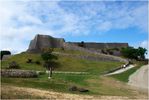
March: The weather starts to warm up, schools have their Spring break and tourists begin to flock to the many attractions available throughout the island. This is Katsuren Castle, which overlooks a peninsula on the East coast of Okinawa.Photo copyright 2009 Michael Lynch.Jun 15, 2009
|
|
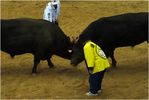
February: A bullfight at the Ishikawa-Dome in Uruma City took place as part of the Lunar New Year festivities. While all of Japan utilizes the Gregorian calendar, many traditions in Okinawa revolve around its historical ties with China. By Michael LynchPhoto copyright 2009 Michael Lynch.Jun 15, 2009
|
|
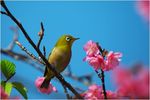
January: A Japanese White Eye visits the Cherry Blossoms. Okinawa is the first place in all of Japan to see these blossoms and they bloom through the month into early February. All photos copyright 2009 Michael Lynch.Photo copyright 2009 Michael Lynch.Jun 15, 2009
|
|
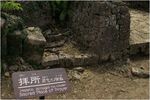
Utaki. A closeup view of a place of worship. Incense is sometimes burned and coins placed in the stone container centered within the utaki stone walls. Photo copyright 2009 Michael Lynch.May 01, 2009
|
|
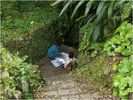
Sacred Well. There are three spring-fed wells within the castle. This one is located in the West enclosure and is also a sacred site where people make ritual offerings. Photo copyright 2009 Michael Lynch.The woman on the left gave consent to take a photo after helping her down the rough, stone stairs.May 01, 2009
|
|

Three Sacred Sites. The South enclosure contains three Utaki (sacred sites), all within a small area, as seen by the signs in this picture. Many Okinawans come to worship at these Utaki and make offerings. Photo copyright 2009 Michael Lynch.From the high ground to the left of this scene, you may be able to see Kudaka-Jima, where locals believe the first Okinawans originated. May 01, 2009
|
|
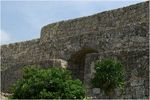
Second Enclosure. A view of the archway and stone construction from inside the 2nd enclosure, looking East. Photo copyright 2009 Michael Lynch.May 01, 2009
|
|
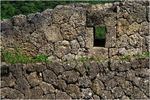
Gun Port. At several locations along the North walls of the castle, gun ports may be seen, where sentries could repel invaders. Photo copyright 2009 Michael Lynch.Many visitors are surprised to learn that firearms were in existence in the 14th century.May 01, 2009
|
|
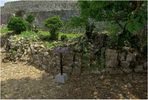
Sacred Site. There are eight special places of worship (Utaki) located within the castle walls. This view looks toward the East from the inside of the 1st enclosure. Photo copyright 2009 Michael Lynch.May 01, 2009
|
|
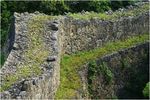
Terraced Walls. A view looking from north to south standing at an elevated point along the inner castle walls. Photo copyright 2009 Michael Lynch.May 01, 2009
|
|
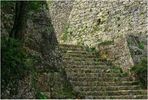
Stone Stairs. They lead to the 2nd enclosure. Visitors should wear sturdy walking shoes, as the stone-lined pathways and stairs can be very difficult to walk on without twisting an ankle. Photo copyright 2009 Michael Lynch.May 01, 2009
|
|
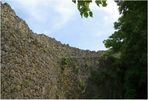
A view from the base of the West enclosure. Constructed in mid-fourteenth century of limestone rocks, placed without the use of mortar, Commodore Perry praised the construction technique on his visit to Okinawa in 1853. Photo copyright 2009 Michael Lynch.May 01, 2009
|
|

World Heritage Marker. Photo copyright 2009 Michael Lynch.May 01, 2009
|
|
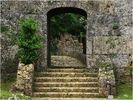
Rear Gate. Most visitors will enter through this gate to the castle, as it is closest to the parking and ticket sales. Photo copyright 2009 Michael Lynch.May 01, 2009
|
|
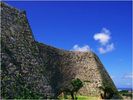
Nakagusuku Castle is part of a World Heritage Site of Okinawan gusuku castles. This is a view looking eastward from the base of the 3d enclosure (migusuku). Photos in this album all by Michael Lynch. Constructed in mid-fourteenth century of limestone rocks, placed without the use of mortar, Commodore Perry praised the construction technique on his visit to Okinawa in 1853. May 01, 2009
|
|

Pickled vegetables.May 01, 2009
|
|
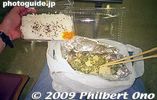
My take-out dinner at Naha Airport before the flight back to Tokyo. Goya-champuru and rice. May 01, 2009
|
|
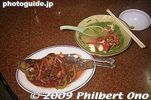
My lunch.May 01, 2009
|
|

She's selling goya (bitter melon) juice. I tried it.May 01, 2009
|
|

Colorful fish in the old Makishi Public Market where you could pick the fish to be cooked for your meal.May 01, 2009
|
|
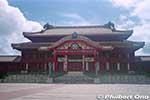
The ornate Seiden Hall, Shuri Castle's most important and central building and National Treasure. Saw it on a previous trip. Very ornate building with wood carvings, lacquered surfaces, paintings, and sculptures. It was meticulously rebuilt in 1992. (首里城 正殿)
Notice the stone dragon pillars flanking the center entrance and sculptures of dragon heads and lion head on the red roof tile roof.May 01, 2009
|
|

Hoshinmon Gate and the Una as seen from the Seiden.This red-and-white plaza is the castle's trademark, the Una courtyard where official ceremonies were held. The red path in the middle was where the King would walk to the main hall.May 01, 2009
|
|
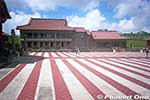
Before the fire, Nanden South Hall (南殿) was connected to the Seiden main hall seen on the left. To enter the Seiden, we had to enter this hall first (entrance on the right). The fire also gutted this building beyond repair and had to be torn down along with the Hokuden North Hall (北殿) on the other side of the Seiden.
Photography inside the main buildings wasn't allowed, so sadly I don't have any photos of the interior.May 01, 2009
|
|

The good old days when Boeing 747s still flew into Naha Airport.May 01, 2009
|
|

The flowers in the jet bridge is a very nice touch at Naha Airport.May 01, 2009
|
|
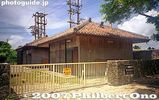
Power voltage stationApr 02, 2007
|
|
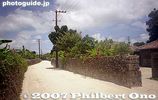
Apr 02, 2007
|
|
| 1547 files on 7 page(s) |
 |
 |
 |
 |
6 |
|